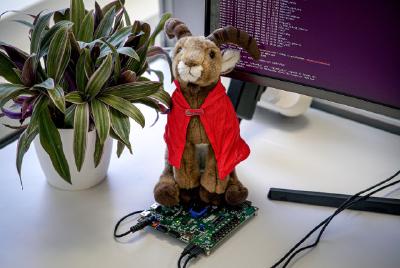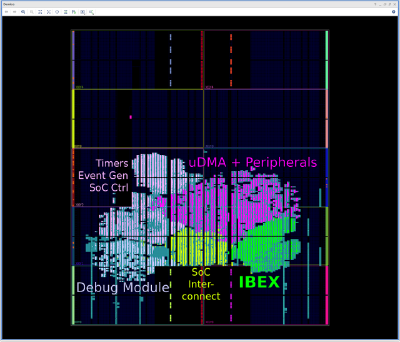Ibex on FPGA - Get stuff executed
by Pirmin Vogel,Our microcontroller-class RISC-V processor core Ibex for sure is a solid base with which to start your own project. Over the past months, we have invested a lot of effort in making the design more mature. This includes refactoring the RTL to make the design more understandable and programmer friendly, adding UVM-based verification to the source tree, but also integrating support for the RISC-V compliance suite and enabling publicly visible, open-source powered continuous integration (CI) to keep the design stable.
However, to actually get your own RISC-V system running, quite some more infrastructure might be needed besides the bare processor core. This includes for example instruction and data memory, input/outputs, peripherals, interrupt controllers, a debug module. But don’t worry, we can help you out! There are now two different system-on-chip designs available to help you get started with Ibex on FPGA.

Arty A7 FPGA Example
This is fairly minimal example for the Arty A7 Artix-7 FPGA Development Board from Digilent that shows you how to integrate Ibex into a top-level design, how to connect memories and how to compile and run a simple application on the core. This example is included in the Ibex tree and is a community contribution by Tobias Wölfel. Thanks @towoe!
PULPissimo
PULPissimo is the advanced microcontroller system from the PULP team at ETH Zürich. It features a powerful uDMA for an autonomous input/output subsystem managing peripherals like UART, SPI, I2C and I2S, supports hardware processing elements, comes with a JTAG debug module and is supported by the PULP software development kit (SDK) that comes with suitable compilers, libraries and even example applications. This complete ecosystem makes PULPissimo a useful starting point for your own project and explorations.
Besides re-integrating Ibex into PULPissimo we also created a new FPGA port for the latest version (Commit ID d37549e). PULPissimo can now be instantiated on the Digilent Nexys Video Artix-7 FPGA board. This board is equipped with a XC7A200T device - the largest Artix-7 FPGA supported by the free Vivado WebPACK Edition - and thus an attractive target for hobbyists.
The picture below visualizes the mapping of the main components inside PULPissimo onto the resources provided by the Nexys Video FPGA board. Ibex utilizes a fairly small part of the overall resources (3500 LUTs, roughly 2.6% of the available resources). There is still plenty of space available for you to implement you own modules such as custom accelerators!

As you might know, Ibex was originally developed as Zero-riscy at ETH Zürich and contributed to us in Dec 2018. We are thus even more happy to enable support for the latest version of Ibex in the PULPissimo system and give something back to the PULP team!
What’s next?
We continue our efforts on making Ibex more robust and extending functionality. We recently added support for Physical Memory Protection and U-mode. This will make Ibex a good candidate for porting embedded and real-time operating systems.
Pirmin Vogel